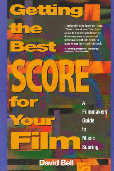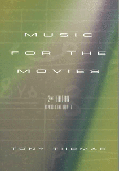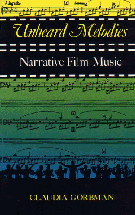
| To
order books on-line from Amazon.co.uk you can click on the links corresponding
to each book listed below |
| books about film music 2 |
| Getting the best score by David Bell, paperback 1st ed.(Nov.1994) Silman-James Press; ISBN: 1879505207 ; Dimensions (in inches): 0.34 x 8.98 x 5.96 |
| see larger picture of cover |
 The subtitle says it
all: A filmmakers' guide to music scoring. Obviously this book is
not targeted at composers. In fact it deals with all the procedures
involved in the process of scoring a film. Getting the Best Score
introduces the reader to cue sheets, spotting sessions, budgets,
and deal making points. As such it is certainly more useful to producers
or directors. Certainly a handy book for those in a bit of a hurry
or who may be slightly scared when confronted to the imposing
volume of On the Tracks - especially if they are not musicians themselves.
The subtitle says it
all: A filmmakers' guide to music scoring. Obviously this book is
not targeted at composers. In fact it deals with all the procedures
involved in the process of scoring a film. Getting the Best Score
introduces the reader to cue sheets, spotting sessions, budgets,
and deal making points. As such it is certainly more useful to producers
or directors. Certainly a handy book for those in a bit of a hurry
or who may be slightly scared when confronted to the imposing
volume of On the Tracks - especially if they are not musicians themselves.
|
| To
order Getting the Best Score click on this link
|
| Hollywood Rhapsody by Gary Marmorstein, Hardcover - 400 pages, 2nd ed. (Nov. 1997) Simon & Schuster; ISBN: 0028645952 ; Dim. (in inches): 1.10 x 9.58 x 6.40 |
|
see larger picture of cover |
 Hollywood Rhapsody
is the first complete history of American movie music, from the
days of the so-called "silent" movies to today's lavish productions.
The book covers everything from the brooding soundtracks of pulp
film noirs to the boisterous songs of the great Disney animated
musicals, from the heyday of Henry Mancini and Michel Legrand
to the great rock scores of the sixties and seventies. The author
combines history, nostalgia, and trivia for an entertaining and
enlightening introduction to the world of film music that is bound
to raise many pleasant memories while also introducing the reader
to the art and craft of film music. Gary Marmorstein is currently
a story analyst for Twentieth Century Fox.
Hollywood Rhapsody
is the first complete history of American movie music, from the
days of the so-called "silent" movies to today's lavish productions.
The book covers everything from the brooding soundtracks of pulp
film noirs to the boisterous songs of the great Disney animated
musicals, from the heyday of Henry Mancini and Michel Legrand
to the great rock scores of the sixties and seventies. The author
combines history, nostalgia, and trivia for an entertaining and
enlightening introduction to the world of film music that is bound
to raise many pleasant memories while also introducing the reader
to the art and craft of film music. Gary Marmorstein is currently
a story analyst for Twentieth Century Fox. A well written and informative book. |
| To
order Hollywood Rhapsody click on this link
|
| Music for the Movies by Tony Thomas - Paperback - 280 pages 2nd Updtd edition (October 1997) Silman-James Press; ISBN: 1879505371 ; Dimensions (in inches): 0.89 x 9.03 x 6.01 |
| see larger picture of cover |
 First published in
1977 Tony Thomas, who was a colleague and a friend of many composers
of his generation, veterans of the 'golden age' of Hollywood, presents
in this book - he was a producer - an insider view of film
music. Certainly this is not the place to find up to date analysis
about contemporary scores but nevertheless this is an interesting
book for anyone looking for behind the scenes accounts about how
it all happened.
First published in
1977 Tony Thomas, who was a colleague and a friend of many composers
of his generation, veterans of the 'golden age' of Hollywood, presents
in this book - he was a producer - an insider view of film
music. Certainly this is not the place to find up to date analysis
about contemporary scores but nevertheless this is an interesting
book for anyone looking for behind the scenes accounts about how
it all happened. In short a book more valuable for people looking for an overview of film music than for aspiring composers searching for technical information. Nevertheless a very entertaining book worth reading. |
| To
order Music for the Movies click on this link
|
| Unheard Melodies/ Narrative Film Music by Claudia Gorbman - Paperback - 190 pages, 1st edition (1987) out of print, Indiana University Press/British Film Institute; ISBN 0253204364; |
 Unheard Melodies is
a very different book than all the ones listed above. Claudia Gorbman
who is a professor a Comparative Literature tries to explain how
music, by definition an abstract art, can function in film, which
on the contrary is - or pretend to be - a very realistic one, and
how music can contribute to the narrative or in the other words
the telling of story. So, why in the first place we - the spectators
- accept this marvellous convention that is underscore. For example
we find the music accompanying the murder of woman in a shower (Psycho)
totally justified, and certainly not at all out of context. On the
contrary we probably are convinced this is one the most striking
element of the scene, something so natural we don't consciously
listen to or even hear (hence the title). All this may seem very
obvious to us but this was not the case at the beginning of film
making era. The author using all the critical apparatus available
to her - semiotics, literary criticism explains how these conventions
were established in the thirties in a chapter titled Classic Hollywood
Practice: The Model of Max Steiner. There is also a very detailed
analysis music/image of Vigo's classic Zero de Conduite (1934, music
by Maurice Jaubert) and a chapter about Hangover Square (1944, music
by Bernard Herrmann).
Unheard Melodies is
a very different book than all the ones listed above. Claudia Gorbman
who is a professor a Comparative Literature tries to explain how
music, by definition an abstract art, can function in film, which
on the contrary is - or pretend to be - a very realistic one, and
how music can contribute to the narrative or in the other words
the telling of story. So, why in the first place we - the spectators
- accept this marvellous convention that is underscore. For example
we find the music accompanying the murder of woman in a shower (Psycho)
totally justified, and certainly not at all out of context. On the
contrary we probably are convinced this is one the most striking
element of the scene, something so natural we don't consciously
listen to or even hear (hence the title). All this may seem very
obvious to us but this was not the case at the beginning of film
making era. The author using all the critical apparatus available
to her - semiotics, literary criticism explains how these conventions
were established in the thirties in a chapter titled Classic Hollywood
Practice: The Model of Max Steiner. There is also a very detailed
analysis music/image of Vigo's classic Zero de Conduite (1934, music
by Maurice Jaubert) and a chapter about Hangover Square (1944, music
by Bernard Herrmann). Film
studies boffins have been obviously delighted with Unheard Melodies
but film makers and composers may find this book thought provoking
inasmuch as a different and refreshing approach to film music is
on offer. |
| This book is currently out of print but you may contact Amazon.com to order a second hand copy. |